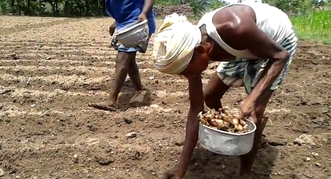Farmers Sowing Healthy Turmeric Rhizomes In Salem District

A year ago, the Trusts initiated a project aimed at bridging these gaps in the farmers’ knowledge. The project, called ‘Dissemination of Integrated Pest Management (IPM) Technologies in Turmeric cultivation among farmers in Salem District, Tamil Nadu’ is being implemented by the Krishi Vigyan Kendra (KVK), Sandhiyur, in 5 villages of Panamarathupatti block, Salem district. The project team found that the average yield per hectare was 12-16 tonnes, where it should have been in the range of 20-25 tonnes per hectare (t/ha). The incidence of disease was 65 percent. In addition to promoting the adoption of PoP, the project team focused on bio-control measures, some which could be produced on the farm itself, in order to reduce cultivation costs.
Today, after only one season, the yield has increased while the expense incurred for the purchase of unwanted chemicals has reduced. As a result, net returns have increased to Rs.225,000/hectare. Farmers are happy because the low plant and rhizome damage means that they can use their own farm-grown good quality rhizomes in the next season, and do not have to spend money to buy rhizome. Yield data also shows that the Integrated Pest Management (IPM) -Turmeric demonstration plots set up by the project team in the farmers’ fields, provided an average yield of 22 t/ha as compared to 13.6 t/ha in the non-IPM farms. Seeing the increased yield, surrounding farmers have been motivated to adopt the PoP as well as bio-control measures. Currently, the adoption rate of the PoP is 80% and purchase of bio-control agents such as Trichoderma viride and Pseudomonas fluorescens has increased to 40-50% in Salem. This is a significant attitudinal change from the past, when farmers avoided buying the much needed fungicides/pesticides due to their high cost. Now, they achieve pest and disease control at a much lower cost.
For farmers like Thiru C. Muthukrishnan from Keerakadu village who achieved a yield of 8,800 kg/acre (22 t/ha), – two tonnes above the State level mean yield – the project intervention has changed the way he cultivates turmeric and allayed his fears. It is noteworthy, that even in severe water shortage, when the temptation to cut his losses and abandon cultivation was high, he continued following the University recommendation. Last year, Muthukrishnan received a net income of Rs. 106,000, resulting in the realisation of his dream of having a bank balance in excess of Rs. 100,000. Today, he proactively organises farmer discussions in his own and surrounding villages, building the confidence of other farmers to adopt IPM. After all, he wants everyone to benefit from IPM.












